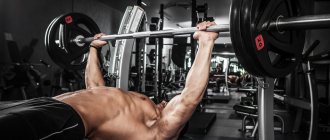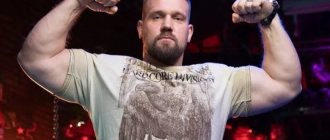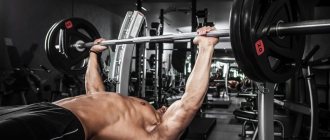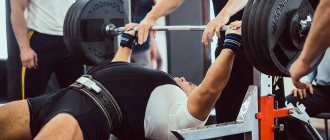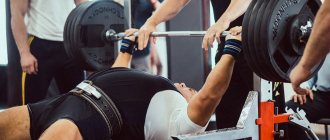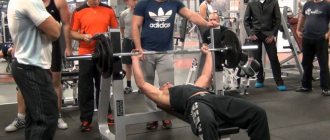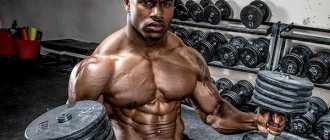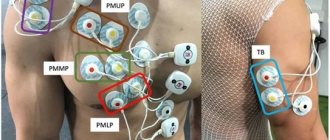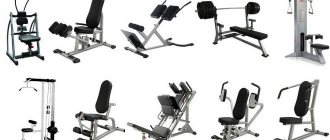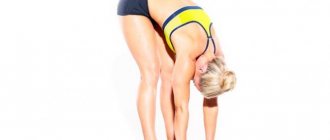The chapter “Biomechanics of the Bench Press” provides an extensive overview of Russian and foreign publications on this topic. Particular attention is paid to the causes and mechanisms of overcoming the “dead zone” and the work of the muscles of the upper and lower extremities.
Samsonova, A.V. Biomechanics of the bench press / A. V. Samsonova, N. B. Kichaikina, G. A. Samsonov // In the book: B. I. Sheiko, K. I. Sarychev Bench press for athletes of all levels of training and physical abilities , 2022.- M.- P. 148-197.
The functioning of the human musculoskeletal system and muscle biomechanics are described in more detail in the book:
Biomechanics of the human musculoskeletal system
BIOMECHANICS OF THE BENCH PRESS
Chapter 6. BIOMECHANICS OF THE BENCH PRESS
6.1 Basic concepts
6.2.Biomechanical analysis of the bench press
6.2.1. Phase structure of the bench press
6.2.2. Kinematic characteristics of the bench press
6.2.2.1. Duration of phases and periods when performing bench press
6.2.2.2. Spatial characteristics of the main phases of the bench press
6.2.2.3. Spatiotemporal characteristics of the main phases of the bench press
6.2.3. Dynamics of the bench press in the phase of lowering the barbell to the chest
6.2.4. Biomechanical analysis of the bench press when an athlete overcomes the “dead zone”
6.2.5. Muscular support for the bench press
6.2.5.1. Participation of the muscles of the upper limb and trunk in the bench press
6.2.5.2. Work of the muscles of the lower extremities
6.3. Bench press options
LITERATURE
- Looking, S.A. Become strong – 2! /S.A.Looking, M.A. Starov, Yu.V. Batygin: Educational and methodological manual on the basics of powerlifting. – Kharkov: K-Center, 1999. – 72 p.
- Doronin, A.M. Physical exercises as a result of integration of the activity of the musculoskeletal system as an analyzer, engine and energy recuperator / A.M. Doronin: Dis... doc. ped. Sciences. – Maikop, 1999. – 258 p.
- Ivanitsky, M.F. Human anatomy (with the basics of dynamic and sports morphology) / M.F. Ivanitsky: textbook. for the institute of physics. cult. / Ed. B.A. Nikityuka, A.A. Gladysheva, F.V. Sudzilovsky. – M.: Physical culture and sport, 1985. – 544 p.
- Kostryukov, V.V. Dynamics of muscle effort in the bench press with constant and variable weights / V.V. Kostryukov // Bulletin of ChSPU im. AND I. Yakovleva, 2011a.– No. 1(69).– Part 2.– P. 82-86.
- Kostryukov, V.V. Improving special strength training of qualified powerlifters based on the use of exercises with variable weights / V.V. Kostryukov: Abstract. dis... cand. ped. Sci. 2011b – p. 25.
- Manko, I.N. Biomechanical features of the manifestation of strength in powerlifting among qualified athletes / I.N. Manko // Scientific notes of the University. P.F. Lesgafta, 2008.– No. 9 (43).– P. 42-46.
- Martyanov, S.S. Analysis of the kinematics of the movement of the barbell when performing the bench press / S.S. Martyanov // Theory and practice of physical culture, 1991. – No. 1. – P. 38-40.
- Prilutsky B.I. Inferior mode of muscle activity during human locomotion / B.I. Prilutsky: Abstract. dis... cand. biol. Sciences. – Riga, 1990. – 23 p.
- Samsonova, A.V. Electrical activity of the muscles of the lower extremities when performing a bench press / A.V. Samsonova, B.I. Sheiko, N.B. Kichaikina, G.A. Samsonov // Scientific notes of Lesgaft University, 2014.- No. 5 (111).- P. 159-165
- Sinelnikov, R.D. Atlas of human anatomy. – T.1. The doctrine of bones, ligaments and muscles / R.D. Sinelnikov. – M.: Medicine, 1972. – 458 p.
- Wilmore, J. Physiology of sports and physical activity / J. Wilmore, D.L. Kostil. – Kyiv: Olympic Literature, 1997. – 503 p.
- Sheiko, B.I. Technique for performing the bench press / B.I. Sheiko, B.G. Lukyanov, D.A. Smolnikov, I.S. Frolov, G.S. Frolov // Iron World, 2007. – No. 6. – P. 128-133.
- Sheiko, B.I. Basic concepts of biomechanics and technique in powerlifting / B.I. Sheiko, P.S. Gorulev, E.R. Rumyantseva, R.A. Tsedov; under general ed. B.I. Sheiko Powerlifting. From beginner to master. – M: Media group “Aktiformula”. – P. 177-278.
- Enoka, R. Fundamentals of kinesiology / R. Enoka. – Kyiv: Olympic Literature, 1998. – 399 p.
- Anderson, CE The Effects of Combining Elasticity and Free Weight Resistance on Strength and Power in Athletes / CE Anderson, GA Sforzo, JA Sigg //Journal of Strength & Conditioning Research, 2008.– V. 22.– No. 2.– P. 567-574.
- Bak, K. Rupture of the pectoralis major: a meta-analysis of 112 cases / K. Bak, EA Cameron, IJ Henderson // Knee Surgery, Sports Traumatology, Arthroscopy, 2000.– V.8.– No. 2.– P 113-119.
- Barker, DG Effect of Kinetically altering a Repetition through the Use of Chain Resistance on Velocity During the Bench Press /DG Barker, RU Newton // Journal of Strength and Conditioning Research, 2009.– V.23.– No. 7.– P. 1941-1946.
- Barnett, C. Effects of variations of the bench press exercise on the EMG activity of five shoulder muscles / C. Barnett, V. Kippers, and P. Turner // Journal of Strength and Conditioning Research, 1995.– V. 9.– No. 4. – P. 222-227.
- Bellar, DM The effects of combined elastic- and free-weight tension vs. free-weight tension on one-repetition maximum strength in the bench press / DM Bellar, MD Muller, JE Barkley, CH. Kim, K. Ida, EJ Ryan, MV Bliss, EL Glickman // Journal of Strength and Conditioning Research, 2011.– V.25.– No. 2.– P. 459-463.
- Bosko, C. Potentiation of the mechanical behavior of the Human skeletal muscle through prestretching /C. Bosko, PV Komi // Acta Physiologica Scandinavica, 1979. – V. 106. – P. 467-472.
- Clemons, JM Effect of grip width on the myoelectric activity of the prime movers in the bench press / JM Clemons, C. Aaron// Journal of Strength and Conditioning Research, 1997.– V.11.– No. 2.– P. 82 -87.
- Doan, BK Effects of Increased Eccentric Loading On Bench Press 1RM/ BK Doan, RU Newton, JL Marsit, NT Triplett-McBride, LP Koziris, AC Fry, WJ Kraemer // Journal of Strength and Conditioning Research, 2002.–No. 16 ( 1).– P. 9–13.
- Duffey, MJ A biomechanical analysis of the bench press / MJ Duffey: Diss. of Degree of Doctor of Philosophy, 2008. – – 120 p.
- Duffey MJ Load supported by the upper extremities during incline and decline pushups / MJ Duffey, VM Zatsiorsky // Medicine and Science in Sports and Exercise, 2003.– V.35.– No. 5.– P62.
- Evangelista, P. DCSS. Power mechanics for power lifters /P. Evangelista: Olympian's News, 2011. – 768 p.
- Elliott, BC A biomechanical analysis of the sticking region in the bench press / BC Elliott, GJ Wilson, G. Kerr// Medicine and Science in Sports and Exercise, 1989.– V.21.– No. 4.– P. 450- 462.
- Gilbert, G. Maximum grip width regulations in powerlifting discriminate against larger athletes/ G. Gilbert, A. Lees// Journal of Sport Sciences, 2003.– V. 21.– No. 4.– P. 299-300.
- Glass, S.C. Electromyographical Activity of the Pectoralis muscle during Incline and Decline Bench Presses / S.C. Glass, T. Armstrong // Journal of Strength and Conditioning Research, 1997. – No. 11(3).– P. 163-167.
- Gomo, OM The effect of grip width on sticking region in bench press /OM Gomo: Thesis of Master Science, Noth-Trondelag University, 2013.– 23 p.
- McGill, S. Ultimate back fitness and performance/S. McGill.– 2009, Waterloo: Wabuno Publichers, Backfitpro Ink.– 317 p.
- Green, CM The Effect of Grip Width on Bench Press Performance and risk of Injury /CM Green, P. Comfort // National Strength and conditioning Association, 2007.– V. 29.– No. 5.– P. 10-14
- Hamilton, N. Bar path in the bench press by wheelchair athletes / N. Hamilton // International Journal of Adapted Physical Educational research, 1995.– V. 2.– P. 61-69.
- Harman, E. Biomechanics of Resistance Exercise / E. Harman /In. N. Baechle, RW Earle Essentials of strength training and Conditioning.–2008.– P. 65-92.
- Keogh, J. A technical report for the Oceania Powerlifting Federation and their member federations /J. Keogh, 2005.– 22p.
- Júnior, V.R. Comparison among the EMG activity of the pectoralis major, anterior deltoid and triceps brachii during the bench press and peck deck exercises /VR Júnior, P. Gentil, E. Oliveira, J. do Carmo // Revista Brasileira de Medicina do Esporte , 2007.– V 13.– No. 1.– P.43-46.
- Król, H. Complex analysis of movement in evaluation of flat bench press performance / H. Król, G. Sobota, A. Nawrat, M. Wilk // XXIV International Symposium of Sport Biomechanics, 2006. – Salzburg. – Austria. – P. 1-4.
- Król, H. Complex analysis of movement in evaluation of flat bench press performance / H. Król, A. Golas, G. Sobota // Acta of bioengineering and biomechanics, 2010.– Vol. 12.– No. 2.– R. 93 -98.
- Lander, JE A comparison between free-weight and isokinetic bench pressing / JE Lander, BT Bates, JA Sawhill, J. Hamill // Medicine and Science in Sports and Exercise, 1985. – V. 17. – No. 3. – R. 344-353
- Lavrence, MA Effects of elastic resistance on concentric force, concentric power and eccentric velocity during the bench press / MA Lavrence // Thesis of Master Science, Ball State University, Muncie, Indiana. – 2010. – 77 p.
- Lehman, G. J. (2005). The influence of grip width and forearm pronation/supination on upper body myoelectric activity during the flat bench press / GJ Lehman // Journal of Strength and Conditioning Research, 2005.– V. 19.– No. 3.– P 587-591.
- Madsen, N., Kinematic factors influencing performance and injury risk in the bench press exercise / N. Madsen, T. McLaughlin// Medicine and Science in Sports and Exercise, 1984.– V.16.– No. 4.– P. 376 -381
- McLaughlin, T. Grip spacing and arm position /T. McLaughlin // Power Research, 19985.– V. 8.– No. 6.– P. 24.
- Medrano, CI Eficacia y seguridad del press de banca. Revisión / CI Medrano, DA Cantalejo // Revista International de Medicina y Ciencias de la Actividad Fisica y del Deporte, 2008. – V. 8. – No. 32. – P. 338-352.
- Newton, R. Influence of load and stretch shortening cycle on the kinematics, kinetics and muscle activation that occur during explosive upper body movements / R. Newton, J. Murphy, B. Humphries, G. Wilson, W. Kraemer, and K. Häkkinen // European Journal of Applied Physiology, 1997.–75.– P. 333–342.
- Pearson, S. Kinematics and Kinetics of the Bench Press and Bench Pull Exercises in a Strength-trained sporting population /S. Pearson, J. Cronin, P. Hume, D. Slyfield //XXVI International Symposium of Sport Biomechanics, 2007. – Ouro Preto. – Brazil.– P. 27-30.
- Penido, LNA Comparação entre força máxima muscular isométrica dinâmica em tres diferentes angulos do exercício supine /LNA Penido, RE Carvalho, FD Pereira, RAA Oliveira, AC Silva, SF da Silva // Rev. Acta Brasileira do Movimento Humano, 2012.– V. 2.– No. 1.– P. 24-33.
- Rippetoe, M. Starting Strength Basic Barbell Training / M. Rippetoe, S. Bradford.– 3rd. Ed., 2011.– Wichita Falls, Texas: Aasggard Company.– 371 p.
- Roczniok Flat bench press on the perspective of regression modeling /R. Roczniok, A. Maszczyk, H. Krol, T. Socha et al. // Life Science Journal, 2013.– V. 10.– No. 4.– P. 1933-1938.
- Sadri, IA Comparison of EMG Fluctuation of Deltoid and Pectoralis Major Muscles in Bench Press / I. Sadri, M. Jourkesh, SM Ostojic, J.Calleja-Gonzalez, A.Ojagi, A. Abolfazi Neshati //Sport Science, 2011.– V.4.– No. 1.– P.30-33.
- Santana, JC A kinetic and electromyographic comparison of the standing cable press and bench press / JC Santana, FJ Vera-Garcia, SM McGill // Journal of Strength and Conditioning Research, 2007.– V. 21.– No. 4.– R. 1271-1279.
- daSilva, S. Supino com Halteres: Um Estudo Eletromiográfico /S. daSilva, M. Gonçalves //Motriz, 2001.– V.7.– No. 1.– P.1-5.
- Sheiko, B. Bench Press technique. Result of the biomechanical analysis of the BP Technique /B. Sheiko, B. Lukyanov, V. Fetisov // Powerlifting USA, 2010. – No. 3 (MAR). – P. 12-13, 74-75.
- Shoepe, TC The Effects of 24 weeks of Resistance Training with Simultaneous Elastic and Free Weight Loading on Muscular Performance of Novice Lifters / TC Shoepe, DA Ramirez, RJ Rovetti, DR Kohler, HC Almstedt //Journal of Human Kinetics, 2011.– V 29.– P. 93-106.
- Trebs, AA An electromyography analysis of 3 muscles surrounding the shoulder joint during the performance of a chest press exercise at several angles / AA Trebs, JP Brandenburg, WA Pitney // Journal of Strength and Conditioning Research, 2010.– V. 24.– No. 7. – R. 1925-1930.
- van den Tillaar, R. A comparison of kinematics and muscle activity between successful and un-successful attempts in bench press // R. van den Tillaar, G. Ettema // Medicine and Science in Sports and Exercise, 2009.– V. 41 .– No. 11.– P. 2056-2063.
- van den Tillaar, R. The “sticking period” in bench press /R. van den Tillaar, G. Ettema // Journal of Sports Sciences, 2010. – V. 28. – No. 5. – P.529-535.
- van den Tillaar, R., Is the occurrence of the sticking region the result of diminishing potentiation in bench press? / R. van den Tillaar, A.H. Saeterbakken G. Ettema // Journal of Sports Sciences, 2012.– V.30.– No. 6.– P. 591-599.
- Wagner, L. L. (1992). The effect of grip width on bench press performance / LL Wagner, SA Evans, JP Weir, TJ Housh, GO Johnson // International Journal of Sports Biomechanics, 1992. – No. 8. – R. 1-10
- Welsch, E. Electromyographic activity of the pectoralis major and anterior deltoid muscles during three upper-body lift / EA Welsch, M. Bird, JL Mayhew // Journal of Strength and conditioning Research, 2005.– No. 19.– P.449- 452.
- Wilson, GJ Bar path profile characteristics for maximal and submaximal loads in the bench press / GJ Wilson, BC Elliott, GK Kerr // International Journal of Sport Biomechanics, 1989. – No. 5. – P. 390-402.
- Wilson, GJ The Effect on Performance of Imposing a Delay during a Stretch-Shorten Cycle movement / GJ Wilson, BC Elliott, GK Kerr //National Sports Research Centre, University of Western Australia, 1991.– 14 s.
History of success
Kirill started going to the gym at the age of 15. Over the next year, the athlete gained 90 kg of weight. At the age of 17 he became a master of sports, and at 22 he set a record in the power biathlon - 380 deadlift and 310 bench press. The overall result is 690 kg. The athlete's height is 197 cm.
After this, the athlete delighted fans with records many times. The highest recorded result: squat - 400 kg, deadlift - 410 kg, bench press - 335 kg, the Russian athlete became world champion. Total weight without equipment is 1082.5 kg.
Sarychev's training program contains three five-hour sessions per week. The athlete performs many exercises, the main ones being squats, bench presses, push-ups, exercises with dumbbells, and performs a number of auxiliary exercises. He trains triceps on machines and uses barbells. Uses sports nutrition.
Tips for beginners
Classes are carried out strictly under the supervision of a trainer or experienced athlete. There is a classic 5x5 training scheme. For it, they use such a weight that it can be used to perform five techniques of 5 approaches. The procedure for calculating weight for training:
An athlete benches 100 kg and wants to achieve another 100. To perform 5x5 exercises, you need to use no more than 80 kg. It is necessary for a beginner to train by feeling, but not by force. The first four exercises are light, then one heavy weight. They do three workouts a week, one of which is hard.
Description of classes
Kirill Sarychev’s training contains a set of exercises:
Monday – heavy squats with 90% load of maximum weight. Perform up to 5 approaches in total.
- Bench press.
- Squats.
- Biceps and triceps training.
- Extension of legs, arms.
Wednesday. A powerlifter performs back exercises:
- Deadlift – hold a weight between your legs and perform deep squats. Trains the broad back muscles.
- Exercises for the trapezius muscle.
- Hyperextension.
Friday program. Bench:
- Bench press heavy 3x5 sets.
- After this, squats are performed.
- Bench press 5x5 sets.
- Wiring.
- Pull-ups – 50 times. Can be divided into 4 approaches.
The athlete takes breaks between exercises, sometimes for 10 minutes.
Having achieved his current form, Kirill allows himself to do squats only a few times a week to maintain strength in his legs for subsequent deadlifts. The athlete does not use maximum weight during training, because after overload, muscle recovery takes about a month.
